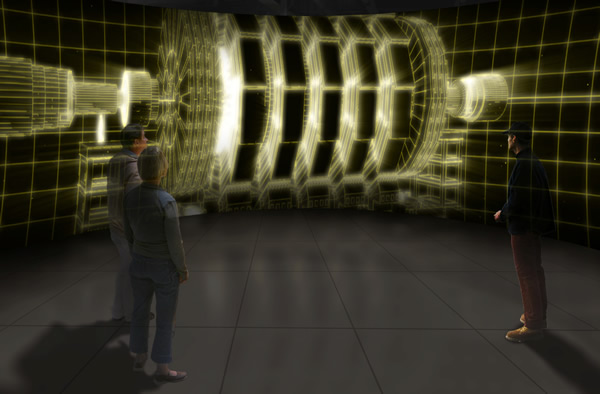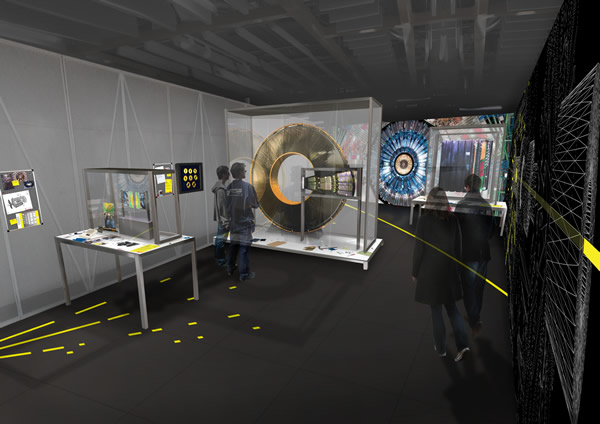Institution news
Christmas is the traditional time for a family outing. The day should be exciting, awe inspiring and totally memorable. So what could be better than a trip to the Hadron Collider exhibition? It ticks all the boxes and will be sure to spark interest in young and old alike. Lesley Lenssen visited the exhibition with her children and science teacher Sylvia Kwan, who share their experiences of Collider, here.
From now until May you no longer need to go to Switzerland to walk the tunnels of CERN, you can experience the excitement of the Hadron Collider at the Science Museum in London. So I took my children, aged 8 and 11, to see their reaction to engineering on a truly global scale. Sylvia Kwan, a science teacher from Hornsey School for Girls, also came along to assess how the exhibition complemented the science curriculum.
The exhibition itself has a range of theatrical devices to capture your attention and make you feel you are really there. You enter through a briefing room, where you sit in the gallery hearing the scientists, played by actors, discuss the project. It is immediately obvious that the scientists are from all over the world; all ages, ethnic groups, and sexes are represented. You quickly gain a clear understanding of what the Large Hadron Collider was set up to achieve and how it does it. Watch out for the tea boy - a cameo played by Brian Cox – he’ll go far!
You then descend deep below the French-Swiss border to the largest scientific experiment ever constructed. Using a range of multimedia techniques the ‘science’ is explained and then you are caught up with the ‘race’ to find the God particle. There are numerous white boards dotted around, with the facts doodled on them, and real size figures talking to you about their part in the experiment. Without having to work hard, you suddenly find you understand how the Collider works and the significance of what they are doing.

You then move from the high-tech subterranean to the practical, rather dingy offices. You can imagine working at CERN, on one hand totally absorbed in the data on your pc, and on the other enjoying a cup of coffee while checking out the notice board. We were all concerned to find out if anyone did find Schrodinger’s missing cat, and was he found dead or alive...?
Rarely have I seen such complex concepts and theories made so accessible. My 8 year old was quickly at home with the idea that atoms are made up of smaller particles, held together with gluons. Whilst the idea of different teams racing to find the Higgs Boson clearly appealed to her competitive nature. By age eleven, a child’s physics knowledge has increased and the collider was vaguely familiar from television programmes. However the scale of the project was clearly quite a thrilling thing. The idea of particles hurling around a 27km ring at almost the speed of light, and then blasting into each other was breathtaking.
Sylvia Kwan found the experience fantastic: “It’s good to see things that you think you won’t understand made accessible and exciting.” Particle physics is really only taught as part of the national curriculum at A-level, but the exhibition is still relevant to the national curriculum for younger visitors because it helps them to understand 'How Science Works'. The introductory briefing is particularly relevant as it shows how scientists have to collaborate and how they test their hypotheses. In school, pupils are encouraged to come up with a hypothesis, then plan and carry out an investigation to test it. The sharing of results with other groups in the class, is just like the scientists collaborating at CERN.
Sylvia added: “Persuading young people to choose a career in engineering relies on them being able to imagine doing that job. Actually seeing the faces behind the project, hearing them describe their role was very powerful. The hard work and dedication was clear, as was the elation of success.” Who wouldn’t want to be part of it?
The culmination of the exhibition was a treat for the computer generated graphics fans – of which I definitely have a couple. You are taken through the collider, accelerated and set on a collision course with another proton. Another triumph for clever technology helping us all understand mind-blowing concepts.
Long term, expensive engineering projects have the potential to inspire, but also to attract criticism for the money and effort involved. This exhibition was keen to point out the spin off benefits of the knowledge gained through the project – be they in cancer treatment and electricity transmission – and the importance of constantly pushing the scientific boundaries. The sooner our budding engineers of the future are inspired by seeing science in action the better.
This exhibition is as far from the traditional museum objects in cases as it is possible to be. And indeed it should be. Capturing cutting edge engineering deserves the latest theatrical display technologies, as art and science really do collide, with spectacular results. We were all completely engaged, and the children have talked about it since, remembering facts and figures and reliving the experience. The tickets are sold for timed slots, and attending early in the morning meant that the exhibition was not crowded and we were able to move freely, following the children’s interest without needing to pause and be patient.
With Christmas approaching the children in your life may well be thinking of things flying through the air at high speed (possibly descending chimneys and delivering presents), so it may not be too much of a stretch to imagine atoms doing the same. I recommend that you take the opportunity to broaden the whole family’s scientific horizons and understand the world’s greatest scientific and engineering experiment.

Collider: the world’s greatest experiment is at the Science Museum from now until 6 May 2014. Timed entry. Adults £10, Concessions £7. For more information and to book your ticket, please visit: http://www.sciencemuseum.org.uk/visitmuseum/Plan_your_visit/exhibitions/collider.aspx